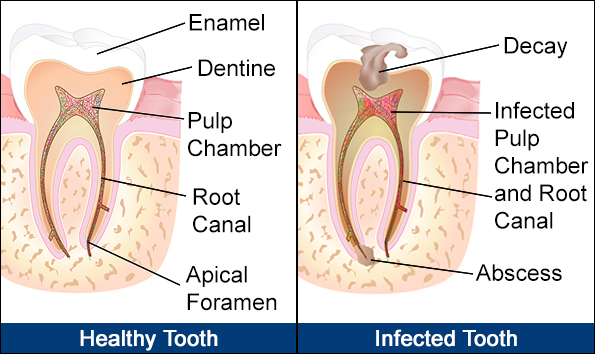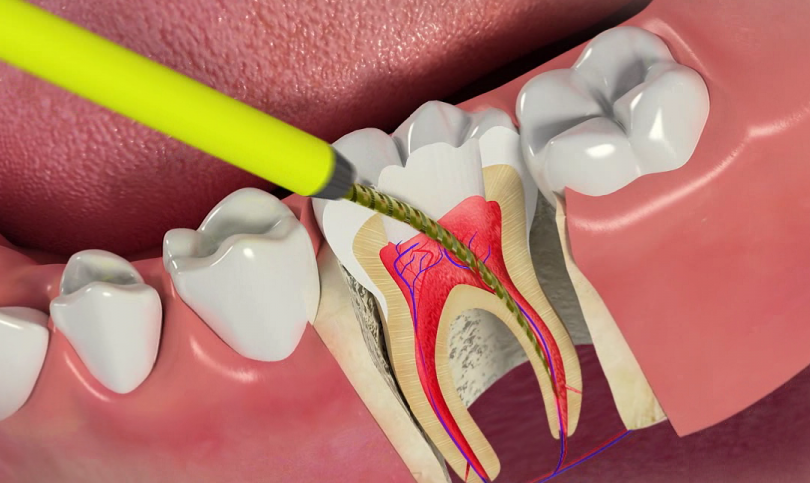Oh my god! Not a Root Canal Treatment…
This is the most common response a dentist will hear on diagnosing a tooth that has decayed enough to need a root canal treatment. Many sights in the dental office such as the drill, sharp tools, needles and even apron clad medical staff might trigger phobia in a patient; but a patient might still cringe the maximum when told these three dark words – Root Canal Treatment.
This article definitely does not advocate performing root canal treatment always. Your dentist undoubtedly will know the best treatment for your damaged tooth. But if you are already aware that you need a root canal treatment or you are already undergoing one, this article will surely help you understand why this treatment is feared and what you could do to overcome that.
Root Canal Treatments do not cause pain, it actually relieves it.Most teeth that need root canal treatment are painful to start with. Which may be the reason you went to your dentist in the first place. The irony of this situation is that, the fear of pain is the number one reason that tens of thousands of people avoid going to the dentist every year. Unfortunately,it is the very same pain that finally gets them to the dental chair. I also know few of my friends and family who have suffered tooth pain for years just to avoid going through a root canal treatment.
So let me try to make it simple to understand the whys and hows of RCT pain.
Why does it pain before the root canal treatment?
You probably have been told that you need a root canal treatment. Which means the decay containing bad bacteria has eaten into your tooth creating a hole and has entered into the soft center or core of your tooth called as the pulp of your tooth. This pulp contains nerves and blood vessels which are easily sensitized by the infection and these nerves transmit pain signals to the brain. Often the infection in the pulp has spread to the root tip of the tooth and escapes into the tiny space between the root and the jaw bone thereby extruding the tooth a bit.

Generally, prevention is the best solution in this case. Good oral hygiene and a visit to the dentist every six months will help you detect the decay in an initial stage when the cavity is still small and a simple filling could fix it. Well, sometimes you do not feel any pain until the decay has reached the pulp so it may have been difficult to avoid this situation. If you have started experiencing pain then taking painkillers will help suppress it (definitely not solve the issue) until you meet your dentist for a solution.
Why does it pain during the root canal treatment?
What if I were to tell you that the root canal treatment does not have to be painful at all anymore! Latest dental tools and technology can eliminate all pain from the moment you are seated on the chair. There is much to know on this topic in a separate article Smile Factors At A Dentist.Your dentist will most likely numb the area of treatment so that you are in no discomfort. The only reason for you to feel pain despite the anesthesia is if the tooth is highly infected. In such a case, your dentist might defer the treatment to a later date and put you on an antibiotic therapy meanwhile to control the infection.

The easiest way to avoid pain during a root canal treatment is to be proactive. Once your doctor has informed you that the anaesthesia is in place and that you shouldn’t be in pain anymore, feel free to give him your feedback. Any pain or discomfort should be reported, so that he can help you feel better by topping up the anaesthetic dose or making changes in his procedure.
Why does it pain after the root canal procedure?
After a root canal treatment is completed no living pulp tissue remains inside the tooth, but nerve endings remain in the ligaments that attach the tooth to the surrounding bone. These ligaments have nerve fibers associated with them that can feel pain. In much, the same way people who have had a limb removed report pain in the missing limb. This pain diminishes over time and usually goes away completely (mostly within a week post treatment).
Some inflammation is caused when the needle like instruments used to clean the root canal slips beyond the tip of the root thereby injecting some debris from the canal into the space between the tooth and the jaw bone or just damaging the ligament in the region. This inflammation usually resolves by itself given sufficient time.
When a tooth is infected and requires a root canal treatment, the periodontal fibers that anchor the tooth to the bone are also irritated and stretched from infection around the roots of the tooth. The trauma of the fibers/ligaments being stretched can also be very painful and will need some time to heal during your root canal recovery.
Anti-inflammatory drugs (painkillers) can help suppress this pain for a few days. Any prolonged pain (longer than three weeks) should be reported to your dentist.
Other causes of pain includes persistent infection, root fracture and instrument breakage within the canal. In these cases the prognosis (outcome of treating the tooth) is generally poor and the patient may need to consider re treatment or extraction.
It could be easier and quicker for you to just remove a painful tooth. It may even be the same for the dentist treating you, yet your dentist advises saving the tooth by doing a root canal treatment. This is to help you preserve what is your own. Extraction and replacement with false teeth is an option you will always have. A couple of visits for root canal therapy can return your own tooth back to its former normal function for good.
Having discussed the above, which is the situation for the vast majority, it is also important to stress that each patient is different and symptoms as well as RCT outcomes maybe different for you. In such a case, you can always contact me with your questions and concerns. I will be glad to address them individually.






Comments by Dr. Dipti S Kumar